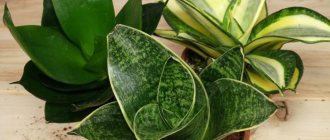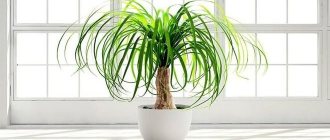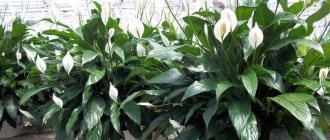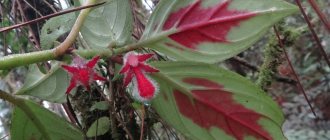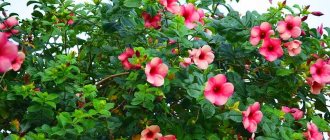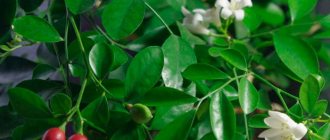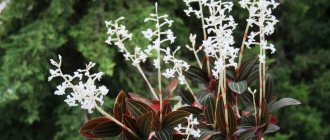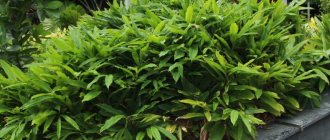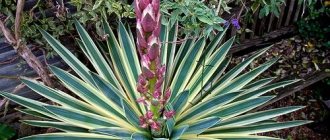Dischidia is a new, exotic, difficult to grow, but extremely beautiful plant. This liana is an epiphyte that in nature lives off other plants. The small main green leaves are not inferior in beauty to the tiny flowers, reminiscent of the brightest stars, shining among the flexible shoots with opposite leaves.
Author of the article
Anna Dmitrieva
Gardener with 15 years of experience.
Dischidia is very popular to photograph due to its appearance. Photos of dischidia cause admiration among lovers of indoor flowers and most would like to have such a plant at home.
Botanical description
In the wild, dischidia grows in the tropics of East Asia, Africa, and America. Some species are cultivated for growing in temperate climates as houseplants. It is part of the large Lastovniev family, close to the sister genus Hoya, but unlike it, it has not been fully studied. About 120 species of flower are known, but only a small part is grown at home.
Dischidia is considered a representative of an epiphytic culture, capable of crawling along supports due to whitish adventitious roots. The height of the compact form of the vine reaches from 0.5 to 1.0 meters. It is possible to achieve a specific size if you practice different methods of tying and growing forms.
Curly and flexible shoots are framed by several types of leaf plates. Some of them are small in the form of an ellipse, pointed at the end, similar to a heart, others are larger in size, fleshy with the ability to fuse the ends in such a way that double jug-shaped or spherical balloons 5 cm long are obtained.
Against the background of a green waterfall of foliage, from spring to autumn, small flowers bloom in the axils, collected in whorls of 3-4 pieces. This usually happens 1-2 times a year. After flowering, pods with seeds are formed.
The foliage stores a supply of water in case of drought. In nature, ants settle in them and drag plant debris here. Moisture promotes rotting of the accumulations, which turn into a nutrient substrate. Over time, aerial roots penetrate into moisture storage containers and receive nutrition. The plant has retained this genetic feature of a subtropical crop - it can independently regulate the level of humidity, which saves it from death in the absence of water.
Each dischidia seed is as volatile as a dandelion and requires caution when working, as it is easily lost.
Content
- General information
- Dischidia species and varieties
- Dyschidia care at home
- Watering dischidia
- Soil for dyschidia
- Fertilizer for dyschidia
- Dischidia bloom
- Pruning dyschidia
- Dyschidia transplant
- Caring for dyschidia during the dormant period
- Dischidia growing from seeds
- Propagation of dyschidia by cuttings
- Diseases and pests
- Conclusion
Ovoid
Ovate (Ovata) is a hanging plant that is unpretentious in cultivation and can withstand drafts. Flower growers note that when an ovoid dischidia is placed in the coldest place under a window, the active period of budding begins and Ovata will soon bloom.
When open, the flowers in different shades of pink and orange reach a diameter of 2.5 cm. This variety is characterized by a greenish-pink color of elongated long stems with neat oval-shaped leaves, on which white veins are clearly visible. The leaf blades are velvety and slightly wavy to the touch.
You can see what the Dischidia Ovate variety looks like in the photo below:
Dischidia Ovate Ovata
Types of dyschidia
There are many varieties of dyschidia growing in nature, about a hundred plants. But only 7 ornamental crops are classified as species. Only two dischidia are cultivated indoors: ovoid and Vidal.
Dischidia Vidal
Vidal's dischidia is often called differently - scalloped. On graceful shoots, light green leaves are located at a great distance from each other. And also additional bag-like leaves filled with moisture are located on the shoots.
Ovate dyschidia
Ovate dischidia is much lighter than Vidal, and the leaves are more elongated, with light veins on the leaf surface.
Rare species
Rare species of dischidia ruscusolifolia and large. It can only be found as a decorative crop in collections.
You can buy different varieties of dischidia in specialized flower shops, as well as in nurseries and from people who breed this plant.
Nummularia
Nummularia (Pangolin kisses) will not leave anyone indifferent. Most often it is grown in hanging containers, where it looks very attractive due to its thick climbing shoots up to 1.5 meters long, densely strewn with light green, round, plump leaves up to 1 cm in diameter.
The leaves are similar to coins, which is why the second name of the variety is coin. Due to its unusual exotic appearance, other translations of the name of the plant are known - dragon's kiss, lizard's kiss.
In almost every leaf node along the entire length of the shoot axillary inflorescences are formed, blooming with small white flowers.
Nummularia differs from its relatives in its slow growth, so if you want to see the beauty of the variety faster, it is better to purchase adult specimens.
It is worth noting that this variety is not cheap, and after purchasing it you will have to arrange “dances” near the bush in order to please the capricious vine by strictly observing the conditions of maintenance.
In the photo below is the variety Dischidia Nummularia:
Dischidia Nummularia
Ruskusolistnaya
The length of the shoots varies from 50 cm to one and a half meters. A characteristic feature is the similarity of the variegated fleshy leaves with hearts, for which the plant is lovingly called a million hearts. Flowering lasts all year round with white or pink-white flowers from which a honey aroma emanates. Requires high humidity and heat for rapid growth. Young specimens feel better in a greenhouse or under a hood.
Dischidea is ready to put up with the dry air for a while, but the roots cannot tolerate the bay after it dries out and begin to rot.
The photo below shows Dischidia Ruscusifolia:
Dischidia Ruscusolifolia
Transfer
Only young vines require annual replanting Adults are transplanted if necessary, no more often than after 2-3 years. Dischidia love light soil with good air permeability. A drainage layer of expanded clay, pebbles, and broken bricks must be laid on the bottom.
Ready-made soil is suitable for bromeliads; if you make it yourself, you need to mix charcoal, fern roots, sphagnum, pieces of pine bark, sand, peat, perlite, and leaf soil.
A million hearts
Overall, Million Hearts performs well due to its heart-shaped leaves and delicate white bell-shaped flowers. Doesn't like being moved to another place during flowering. The flowers immediately dry out and only a few remain on the stem. It differs from ruscusolifolia in the color of the foliage; this variety has a bright green color. At the slightest deviation from the conditions of maintenance, the trunk dries out, the foliage begins to wrinkle and fade. Spraying with soft water and alternating fertilizer for orchids in low concentration stimulates growth and flowering.
Dischidia Million Hearts
Feeding and pruning
During the growing season, which lasts from June to September, dischidia responds well to fertilizer every two weeks, especially if it is added as a top layer with increased concentrations of nitrogen and phosphorus. In the fall, when the plant is preparing for winter rest, phosphorus fertilizers are supplemented with potassium.
Feeding must be stopped two months before the first frost on the ground, so as not to damage winter hardiness. To a layer of nutrients made according to all the rules, Dischidia ovata, like any other member of the family, will react with abundant flowering. If you ignore bait, flowering will become sparse and the shoots will stretch unsightly upward. By skillfully using ordinary pruning shears, you can form a crown in the shape of a cube, sphere or any geometric figure. It is then that the result of your efforts will become attractive even among the not-too-boring garden flora.
Grebeshkovaya
When grown on a support, it is possible to create a living green wall due to the large number of aerial roots, which looks very picturesque in the interior of the room. The climbing epiphytic plant has original comb-like foliage and amazing blooms of purple pitcher flowers. When watering a flower you need to be restrained. The substrate should be moist, but not swampy. When there is a lack of light, dischidia sheds its leaves, so in winter you need to take care of artificially illuminating the bushes.
Dischidia Grebeshkovaya
Appleleaf
The name of the variety is associated with the similarity of the leaf blades to apple leaves, which are as large and round as the fruit. On the surface of the dark green leaves, a scattering of white inclusions is visible, which resembles marble. It has a negative attitude towards direct sunlight, because of which burns appear on the leaf plates. It is possible to grow in a florarium under artificial lighting. For normal development, you need to ensure that the humidity does not drop below 50%.
The ideal place for growing is the bathroom if the room has windows with western or eastern orientation. In this place, all the dischidia needs is warmth and humidity.
Dischidia Applefolia
Possible problems
Mallow (75 photos): types, proper care
Atypical diseases can also overtake dyschidia.
- Rotting of shoots and roots is very likely with excessive soil moisture.
- The leaf blades turn red - not from shame, but from excess light.
- If fleshy pitcher-shaped leaves do not appear, dischidia suffers from moisture deficiency.
Aphid. A parasite that settles in large colonies that are impossible to miss. May be black, green, brown. It not only inhibits the normal development of the plant, but also promotes the development of sooty fungus with sweet secretions.
The affected plant is treated with insecticides - Aktara, Iskra, Actellik, Akarin, Confidor, Arrivo. Infusions of garlic, tomato tops, and onion peels can help.
Mealybug. A sucking parasite that settles on young shoots and the inside of leaves. The oval-shaped body is covered with a snow-white coating reminiscent of flour.
Affected plants very quickly stop growing and die. To avoid this, use the following products - Admiral, Vertimek, Iskra, Biotlin, Mospilan, Calypso, Fitoverm, Apploud.
Spider mite. Despite their microscopic size, they can cause great harm to plants if measures are not taken. The presence is revealed by the thin webs covering the plant and the many small punctures on the outside of the leaves.
The plant is wiped with a soap solution and sprayed with one of these acaricides - Oberon, Sunmite, Apollo, Akarin, Nissoran.
And for the most curious, we suggest watching a video about dyschidia
Vidalia
Two or three times a year you can observe Vidalia dischidia blooming with soft pink flowers against a background of bright green foliage. You should not be overzealous with lighting, since if there is too much light, the round leaves turn reddish, which reduces the decorative value of the bushes. Prefers a modest dose of fertilizer for foliage crops and succulents, which is applied at the root or added to warm water for spraying.
Dischidia Vidalia
Caring for dyschidia during the dormant period
The plant's dormant period begins at the beginning of winter and lasts until spring. At this time, the temperature in the room should be reduced to 18 degrees, watering should be reduced to once a week, and it is advisable to remove spraying altogether or carry it out once every three days.
Fertilizing should also not be applied in winter. With the onset of spring, active skincare procedures need to be resumed.
Khirsuta
in the collections of flower growers . The leaves are round in shape with dense pubescence, pointed at the ends, and a relief pattern is clearly visible on the surface. Produces buds of a wonderful wine color. More often they are grown in hanging containers, from which stems up to one and a half meters long hang down. Throughout the year, you should not drop the temperature below 18 degrees Celsius.
Dischidia Hirsut
Watering
Moderate , do not water the vine often. It is recommended to keep it in the pot until the surface of the soil dries.
Approximate standards : in summer 2-3 times a month, in winter the interval is 22-31 days.
Air humidity is maintained high by regularly spraying the dischidia or placing it in a tray with moistened stones (expanded clay, pebbles, broken bricks).
Some gardeners grow vines in greenhouses and terrariums.
water is used for all procedures. This is achieved by settling water for 3-4 days, boiling, using filtered, melted and rainwater.
Reproduction
Seeds
This is a labor-intensive and troublesome method that requires care when sowing, since volatile seeds are easy to lose. It is advisable to use freshly harvested seed material with high germination rate. Suitable soil for seed propagation from leaf soil and peat. Add 2 parts of perlite to the mixture.
Step-by-step instruction:
Before sowing, the seeds are processed, removing fluff.- Moisten the soil, lay it loosely on top of it, without deepening the dischidia seeds.
- Sprinkle with a thin layer of soil, no more than 5 mm.
- Create greenhouse conditions by covering with a film or glass cap. Regularly ventilate and moisten with a spray bottle.
- Shoots appear by the end of the first ten days, but you should not disturb them, but wait until the first true leaves appear. then dived into separate containers.
Seedlings are kept at a temperature of 20-25 degrees Celsius in bright light without direct sunlight.
Cuttings
It is considered a simple method of propagation that is suitable for beginners.
Cuttings 8-10 cm long are cut at an angle from the upper parts of the shoots, not forgetting to sprinkle the cut areas with charcoal.
Cuttings are treated with Kornevin.
Due to the fact that there are many aerial roots on them with sufficient moisture in the soil mixture of peat and sand, covered with plastic film, rooting occurs within three weeks.
The greenhouse should be regularly ventilated and moistened and the temperature maintained at +20-25°C.
Some gardeners practice rooting cuttings in sphagnum moss in a tightly closed plastic cake box. You must remember to regularly ventilate and moisten the moss.
Planting material can be taken from leaf balloons - moisture accumulators. Under favorable conditions, daughter plants develop in them. To obtain them, the leaf plate is carefully cut with a sharp blade, the sprout is removed from there and planted in a permanent place in a suitable container. No pre-processing required.
Pests and diseases
The flower belongs to the weakly resistant type. Overwatering can lead to rotting of the root system and shoots. The main enemies of the plant are aphids and spider mites. Special insecticides are used as a solution. Health problems manifest themselves as reddening of leaves that have been exposed to direct sunlight. The tendrils begin to darken, the leaves become deformed and gradually shred due to low humidity levels.
| Growing | Can be grown in artificial conditions, copes well with high temperatures and indirect sunlight. |
| Humidity | Does not require artificial air humidification. |
| Feeding and pruning | Two feedings per year, fertilizer must be diluted in April and July. |
| Flowering period | Once a year, from the last days of June to the beginning of October. |
| Landing, transplant | From mid-spring to late summer. |
| Reproduction | By cuttings, grafting, layering and seed method. |
| Pests | Thrips, spider mites, aphids and whiteflies. |
| Diseases | Root rot. |
